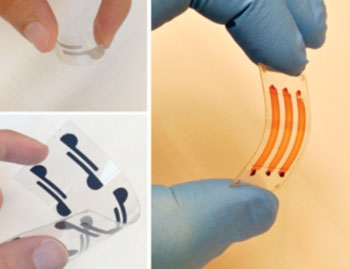Next Generation of Rapid Diagnostic Assays Will Combine Disposable Test Materials with Smartphone Applications
By LabMedica International staff writers
Posted on 27 Apr 2015
The new generation of rapid diagnostic tests will reflect advances in both materials sciences and instant communications via the Internet and social media.Posted on 27 Apr 2015
Current diagnostic assays commonly require long assay time, sophisticated infrastructure, and expensive reagents that are not compatible with resource-constrained and geographically isolated settings. While paper and flexible material-based platform technologies provide alternative approaches for the development of point-of-care (POC) diagnostic assays for broad applications in medicine, they lack the capability of transferring test results to a central location.

Image: Thin, lightweight, and flexible materials integrate cellulose paper and flexible polyester films as new diagnostic tools to detect biological agents in whole blood, serum, and peritoneal fluid (Photo courtesy of Florida Atlantic University).
Investigators at Florida Atlantic University (Boca Raton, USA), Stanford University (Palo Alto, CA, USA), and Harvard University (Cambridge, MA, USA) have been working to integrate cellulose paper and flexible polyester film-based assays with dedicated smartphone applications.
In a recently published paper, the investigators presented a snapshot of the current state of the art. They described the use of three different paper and flexible material-based platforms with embedded electrical and optical sensing modalities to develop tests for the selective and accurate capture and detection of multiple biological targets. Finger prick volume equivalents of biological specimens such as whole blood, plasma, and peritoneal dialysis effluent were tested. Viruses (Human immunodeficieny virus 1), bacteria (Escherichia coli and Staphylococcus aureus), and cells (CD4+ T lymphocytes) were identified with clinically relevant levels of detection and sensitivity. A smartphone application was developed that allowed images of the test results to be sent from a cellular telephone for analysis anywhere in the world.
"The future of diagnostics and health monitoring will have potentially cell-phone based or portable readers sipping saliva or blood and continuously monitoring human health taking it way beyond where we are with counting steps today," said senior author Dr. Uktan Demirci, associate professor of radiology at Stanford University.
The paper was published in the March 6, 2015, online edition of the journal Nature Scientific Reports.
Related Links:
Florida Atlantic University
Stanford University
Harvard University













